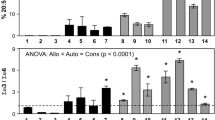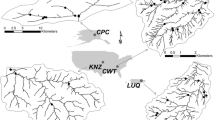Abstract
A central tenet of ecological stoichiometry is that consumer elemental composition is relatively independent of food resource nutrient content. Although the P content of some invertebrate consumer taxa can increase as a consequence of P-enriched food resources, little is known about how ecosystem nutrient loading can affect the elemental composition of entire consumer assemblages. Here we examine the potential for P enrichment across invertebrate consumer assemblages in response to chronic high P loading. We measured elemental ratios in invertebrate consumers and basal food resources in a series of streams in lowland Costa Rica that range widely in P levels (2-135 μg l−1 soluble reactive P). Streams with high P levels receive natural long-term (over millennia) inputs of solute-rich groundwater while low-P streams do not receive these solute-rich groundwater inputs. P content of leaf litter and epilithon increased fourfold across the natural P gradient, exceeding basal resource P content values reported in the literature from other nutrient-rich streams. Invertebrate consumers from the high-P study stream were elevated twofold in P content across multiple taxonomic and functional feeding groups, including predators. Our results strongly support the hypothesis that elevated P content in consumers feeding on P-enriched food resources is a consequence of deviation from strict homeostasis. In contrast to prior studies, we found that between-stream variation in P content of a given taxon greatly exceeded within-stream variation among different taxa, suggesting that environment may be as important as phylogeny in controlling consumer stoichiometry. Relaxing the assumption of strict homeostasis presents challenges and opportunities for advancing our understanding of how nutrient limitation affects consumer growth. Moreover, our findings may provide a window into the future of how chronic anthropogenic nutrient loading can alter stoichiometric relationships in food webs.






Similar content being viewed by others
References
Acharya K, Kyle M, Elser JJ (2004) Biological stoichiometry of Daphnia growth: an ecophysiological test of the growth rate hypothesis. Limnol Oceanogr 49:656–665
Allen AP, Gillooly JF (2008) Towards an integration of ecological stoichiometry and the metabolic theory of ecology to better understand nutrient cycling. Ecol Lett 12:369–384
American Public Health Association (APHA) (1998) Standard methods for the examination of water and wastewater, 20th edn. American Public Health Association, New York
Andersen T, Hessen DO (1991) Carbon, nitrogen, and phosphorus content of freshwater zooplankton. Limnol Oceanogr 36:807–814
Ardón M, Stallcup LA, Pringle CM (2006) Does leaf quality mediate the stimulation of leaf breakdown by phosphorus in Neotropical streams? Freshwater Biol 51:616–633
Boersma M, Aberle N, Hantzsche FM, Schoo KL, Wiltshire KH, Malzahn AM (2008) Nutritional limitation travels up the food chain. Int Rev Hydrobiol 93:479–488
Bowman MF, Chambers PA, Schindler DW (2005) Changes in stoichiometric constraints on epilithon and benthic macroinvertebrates in response to slight nutrient enrichment of mountain rivers. Freshwater Biol 50:1836–1852
Cain DJ, Luoma SN, Axtmann EV (1995) Influence of gut content in immature aquatic insects on assessments of environmental metal contamination. Can J Fish Aquat Sci 52:2736–2746
Carpenter SR, Caraco NF, Correll DL, Howarth RW, Sharpley AN, Smith VH (1998) Nonpoint pollution of surface waters with phosphorus and nitrogen. Ecol Appl 8:559–568
Carrillo P, Villar-Argaiz M, Medina-Sánchez JM (2001) Relationship between N:P ratio and growth rate during the life cycle of calanoid copepods: an in situ measurement. J Plankton Res 23:537–547
Cross WF, Benstead JP, Rosemond AD, Wallace JB (2003) Consumer-resource stoichiometry in detritus-based streams. Ecol Lett 6:721–732
Cross WF, Wallace JB, Rosemond AD, Eggert SL (2006) Whole-system nutrient enrichment increases secondary production in a detritus-based ecosystem. Ecology 87:1556–1564
DeMott WR, Gulati RD, Siewertsen K (1998) Effects of phosphorus-deficient diets on the carbon and phosphorus balance of Daphnia magna. Limnol Oceanogr 43:1147–1161
Elser JJ, Schampel JH, Kyle M, Watts J, Carson EW, Dowling TE, Tang C, Roopnarine PD (2005) Response of grazing snails to phosphorus enrichment of modern stromatolitic microbial communities. Freshwater Biol 50:1826–1835
Evans-White MA, Stelzer RS, Lamberti GA (2005) Taxonomic and regional patterns in benthic macroinvertebrate elemental composition in streams. Freshwater Biol 50:1786–1799
Fink P, Von Elert E (2006) Physiological responses to stoichiometric constraints: nutrient limitation and compensatory feeding in a freshwater snail. Oikos 115:484–494
Frost PC, Benstead JP, Cross WF, Hillebrand H, Larson JH, Xenopoulos MA, Yoshida T (2006) Threshold elemental ratios of carbon and phosphorus in aquatic consumers. Ecol Lett 9:774–779
Hillebrand H, Frost P, Liess A (2008) Ecological stoichiometry of indirect grazer effects on periphyton nutrient content. Oecologia 155:619–630
Jackson JK, Sweeney BW (1995) Egg and larval development times for 35 species of tropical stream insects from Costa Rica. J North Am Benthol Soc 14:115–130
Jones JB Jr, Wolf B, Mills HA (1991) Plant analysis handbook 1: methods of plant analysis and interpretation. Micro-Macro, Athens, pp 195–196
Merritt RW, Cummins KW (1996) An introduction to the aquatic insects of North America, 3rd edn. Kendall/Hunt
Peckarsky BL, Hughes JM, Mather PB, Hillyer M, Encalada AC (2005) Are populations of mayflies living in adjacent fish and fishless streams genetically differentiated? Freshwater Biol 50:42–51
Pringle CM, Triska FJ (1991) Effects of geothermal waters on nutrient dynamics of a lowland Costa Rican stream. Ecology 72:951–965
Pringle CM, Triska FJ, Broder G (1990) Spatial variation in basic chemistry of streams draining a volcanic landscape on Costa Rica’s Caribbean slope. Hydrobiologia 206:73–85
Pringle CM, Rowe GL, Triska FJ, Fernandez JF, West J (1993) Landscape linkages between geothermal activity and solute composition and ecological response in surface waters draining the Atlantic slope of Costa Rica. Limnol Oceanogr 38:753–774
Ramírez A, Pringle CM (1999) Invertebrate drift and benthic community dynamics in a lowland neotropical stream, Costa Rica. Hydrobiologia 386:19–26
Ramírez A, Pringle CM (2001) Spatial and temporal patterns of invertebrate drift in streams draining a Neotropical landscape. Freshwater Biol 46:47–62
Ramírez A, Pringle CM (2006) Fast growth and turnover of chironomid assemblages in response to stream phosphorus levels in a tropical lowland landscape. Limnol Oceanogr 51:189–196
Ramírez A, Pringle CM, Douglas M (2006) Temporal and spatial patterns in stream physicochemistry and insect assemblages in tropical lowland streams. J North Am Benthol Soc 25:108–123
Rosemond AD, Pringle CM, Ramírez A, Paul MJ, Meyer JL (2002) Landscape variation in phosphorus concentration and effects on detritus-based tropical streams. Limnol Oceanogr 47:278–289
Sanford RL, Paaby P, Luvall JC, Phillips E (1994) Climate, geomorphology, and aquatic systems. In: McDade LA, Bawa KS, Hespenheide HA, Hartshorne GS (eds) La Selva: ecology and natural history of a neotropical rainforest. University of Chicago Press, Chicago, pp 19–33
SAS Institute (2001) SAS version 8.2 for Windows. SAS Institute, Cary
Schade JD, Kyle M, Hobbie SE, Fagan WF, Elser JJ (2003) Stoichiometric tracking of soil nutrients by a desert insect herbivore. Ecol Lett 6:96–101
Shimizu Y, Urabe J (2008) Regulation of phosphorus stoichiometry and growth rate of consumers: theoretical and experimental analyses with Daphnia. Oecologia 155:21–31
Singer GA, Battin TJ (2007) Anthropogenic subsidies alter stream consumer-resource stoichiometry, biodiversity, and food chains. Ecol Appl 17:376–389
Stelzer RS, Lamberti GA (2001) Effects of N:P ratio and total nutrient concentration on stream periphyton community structure, biomass, and elemental composition. Limnol Oceanogr 46:356–367
Sterner RW, Elser JJ (2002) Ecological stoichiometry: the biology of elements from molecules to the biosphere. Princeton University Press, Princeton
Sterner RW, Hessen DO (1994) Algal nutrient limitation and the nutrition of aquatic herbivores. Annu Rev Ecol Syst 25:1–29
Triska FJ, Pringle CM, Duff JH, Avanzino RJ, Ramírez A, Ardón M, Jackman AP (2006) Soluble reactive phosphorus transport and retention in tropical, rainforest streams draining a volcanic and geothermally active landscape in Costa Rica: long-term concentration patterns, pore water environment, and response to ENSO events. Biogeochemistry 81:131–143
Urabe J, Watanabe Y (1992) Possibility of N or P limitation for planktonic cladocerans: an experimental test. Limnol Oceanogr 37:244–251
Vanni MJ, Flecker AS, Hood JM, Headworth JL (2002) Stoichiometry of nutrient recycling by vertebrates in a tropical stream: linking species identity and ecosystem processes. Ecol Lett 5:285–293
Woods HA, Perkins MC, Elser JJ, Harrison JF (2002) Adsorption and storage of phosphorus by larval Manduca sexta. J Insect Physiol 48:555–564
Acknowledgments
We are grateful to Minor Hidalgo for assistance in the field and Tom Maddox for laboratory assistance. Thanks to Wyatt Cross for graciously sharing data, and to Andrew Mehring and Darold Batzer for statistical advice. Additionally, this manuscript was greatly improved by discussion with Jon Benstead, John Davis, Amy Rosemond, Becky Bixby, Susan Kilham, Steve Thomas, John Duff, Frank Triska, and the Pringle lab. Research funding was provided by the National Science Foundation (DEB 0545463; C. M. Pringle, F. J. Triska, and A. Ramírez). G. E. Small is supported in part by the United States Environmental Protection Agency (EPA) under the Science to Achieve Results (STAR) Graduate Fellowship Program. EPA has not officially endorsed this publication and the views expressed herein may not reflect the views of the EPA. All experiments and sampling discussed here comply with both USA and Costa Rican regulations.
Author information
Authors and Affiliations
Corresponding author
Additional information
Communicated by Robert Hall.
Electronic supplementary material
Below is the link to the electronic supplementary material.
Rights and permissions
About this article
Cite this article
Small, G.E., Pringle, C.M. Deviation from strict homeostasis across multiple trophic levels in an invertebrate consumer assemblage exposed to high chronic phosphorus enrichment in a Neotropical stream. Oecologia 162, 581–590 (2010). https://doi.org/10.1007/s00442-009-1489-4
Received:
Accepted:
Published:
Issue Date:
DOI: https://doi.org/10.1007/s00442-009-1489-4




